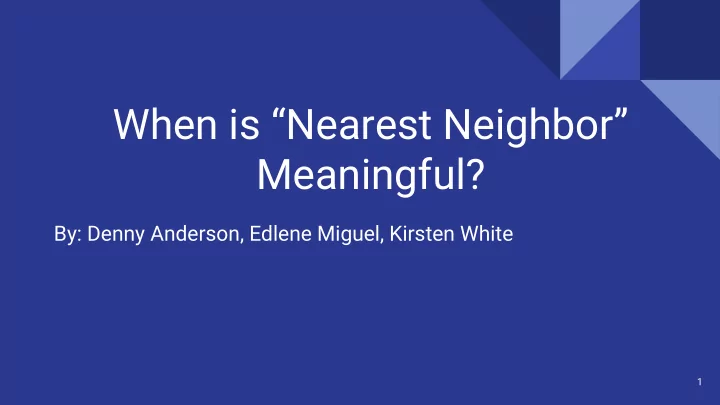

When is “Nearest Neighbor” Meaningful? By: Denny Anderson, Edlene Miguel, Kirsten White 1
What is Nearest Neighbors (ML technique)? “Given a collection of data points and a query point in an m-dimensional metric space, find the data point that is closest to the query point.” 1 1 4 1 4 1 The query point (green) would be classified as “4” 2 because its nearest neighbor (indicated by the 2 arrow) is classified as “4” 3 3 2
Introduction ● This paper makes three main contributions: ○ As dimensionality increases, the distance to the nearest neighbor is approximately equal to the distance to the farthest neighbor This may occur with as few as 10 - 15 dimensions ○ ○ Related work does not take into account linear scans 3
Significance of Nearest Neighbors ● NN is meaningless when all data points are close together. We can count the number of points that fall into an m-dimensional sphere ● beyond the nearest neighbor in order to quantify how meaningful the result is. ● The points inside the sphere are valid approximate answers to the NN problem. 4
Nearest Neighbors in Higher Dimensions ● We analyze the distance between query points and data points as the dimensionality changes. NN can become meaningless at high dimensions if all points converge to the ● same distance from the query point. 5
Nearest Neighbors in Higher Dimensions 6
Nearest Neighbors in Higher Dimensions If m increases and all points converge to the same distance from the query ● point, NN is no longer meaningful. 7
Applications in Higher Dimensions ● The query can be meaningful if it is a small distance away from a data point. This becomes increasingly difficult as the number of dimensions increases. ● We require that the query must fall within one of the data clusters. ● ● Sometimes, the data set can be reduced to a lower dimensionality, which helps produce a meaningful result. 8
Experiment ● NN simulations Uniform [0,√12] ○ ○ N(0,1) Exp(1) ○ ○ Variance of distributions: 1 Dimensionality varied between 1 and 100 ○ ○ Dataset sizes: 50K, 100K, 1M, and 10M tuples ε varied between 0 and 10 ○ 9
Results ● The percentage of data retrieved rises quickly as dimensionality is increased. Even though correlation and variance changed, the recursive workload ● behaved almost the same as the independent and identically distributed (IID) uniform case. 10
Two Datasets from an Image Database System ● 256-dimensional color histogram dataset (1 tuple per image) Reduced to 64 dimensions by principal components analysis ● ~13,500 tuples in dataset ● ● Examined percentage of queries where > 50% of data points were within ε of the NN. k = 1: 15% of queries had > 50% of data within factor of 3 of distance to NN ● k = 10: 50% of queries had > 50% of data within factor of 3 of distance to the ● 10th NN ● Changing k has the most dramatic effect when k is small 11
Nearest Neighbor Performance Analysis ● High dimensional data can be meaningful in NN queries. The trivial linear scan algorithm needs to be used as a sanity check. ● 12
Related Work ● The Curse of Dimensionality ○ Related to NN problems, it indicates that a query processing technique performs worse as the dimensionality increases Only relevant in analyzing the performance of a NN processing technique, ○ not the main results 13
Related Work ● Computational Geometry ○ An algorithm that retrieves an approximate nearest neighbor in O(logn) time for any data set An algorithm that retrieves the true nearest neighbor in constant ○ expected time under IID dimensions assumption ○ Constants are exponential in dimensionality 14
Related Work ● Fractal Dimensions ○ Papers suggest that real data sets usually demonstrate self-similarity and that fractal dimensionality is a good tool in determining performance Future work: are there real data sets for which the fractal dimensionality ○ is low, but there is no separation between nearest and farthest neighbors? 15
Conclusions ● More care needs to be taken when thinking of nearest neighbor approaches and high dimensional indexing algorithms If data and workloads don’t meet certain criteria, queries become ● meaningless ● Evaluation of NN workload: make sure that the distance distribution allows for enough contrast Evaluation of NN processing techniques: test on meaningful workloads and ● account for approximations 16
References Beyer, Kevin, Jonathan Goldstein, Raghu Ramakrishnan, and Uri Shaft. "When is “nearest neighbor” meaningful?." In Database Theory—ICDT’99, pp. 217-235. Springer Berlin Heidelberg, 1999. 17
Questions? 18
Recommend
More recommend